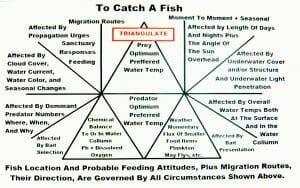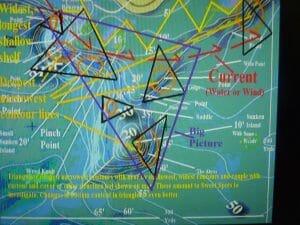 The science of Bass Fishing is a matter of triangulating the individual features noted to see where the triangles overlap or come together closely on a lake bottom contour map.
The science of Bass Fishing is a matter of triangulating the individual features noted to see where the triangles overlap or come together closely on a lake bottom contour map.
It starts with water flow and time of year. Then the different cycles per targeted species for preferred water temperature ranges winter sanctuaries, spawning, post spawn, and summer to fall roaming grounds come into play. Those summer spots are largely dependent on what food is available and in what quantities.
Knowing that, we have to study the prey habits as well and include cover and shade as in depth.We also have to include plankton blooms , may fly’s, etc. because those are what small prey, newly hatched target fish, and bigger fish eat ” in the food chain” in the moment where food is abundant.
The darker the water the higher in the water column you’ll find fish. The more the water is blocked to cause current slow down on the edges of fast and the slower the water, the better. That slowed down water can mean “Things” which block the flow both vertically and horizontally – it’s not just weeds, underwater points or rock piles, it can also mean the bottom rises or sinks in in a relatively short distance or space. It then can also mean water temperature: warm water moves faster than cold water.
 The Thermocline makes a often missed good example of where water speeds up and / or slows down – the few feet where the water temperature drops dramatically or increases. That can also happen around underwater springs or stream influx. Those spots then will be the best POSSIBLE spots to investigate.
The Thermocline makes a often missed good example of where water speeds up and / or slows down – the few feet where the water temperature drops dramatically or increases. That can also happen around underwater springs or stream influx. Those spots then will be the best POSSIBLE spots to investigate.
By Richard Ziert
Discover the ultimate resource for bass fishing enthusiasts with Bass Angler Magazine! Packed with expert tips, the latest cutting-edge techniques, and in-depth articles, our magazine is your go-to guide for mastering the art of bass fishing. Whether you’re a seasoned pro or just getting started, Bass Angler Magazine delivers the insights and inspiration you need to reel in the big ones. Subscribe today and elevate your angling game!


